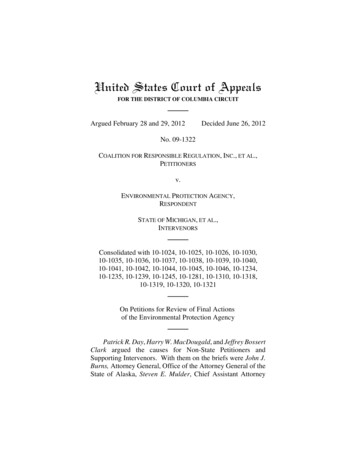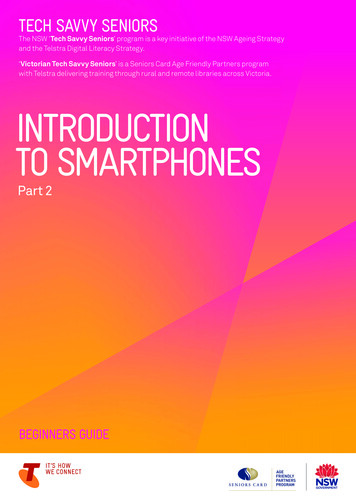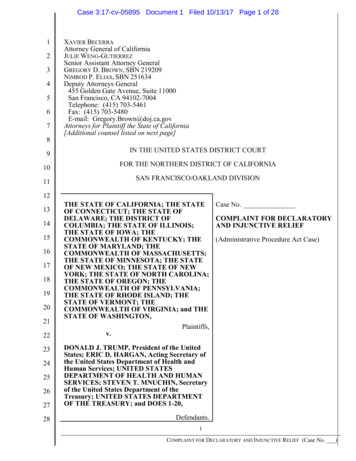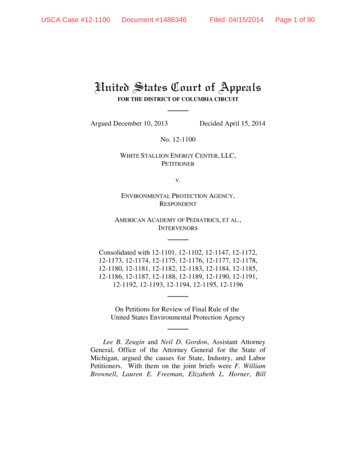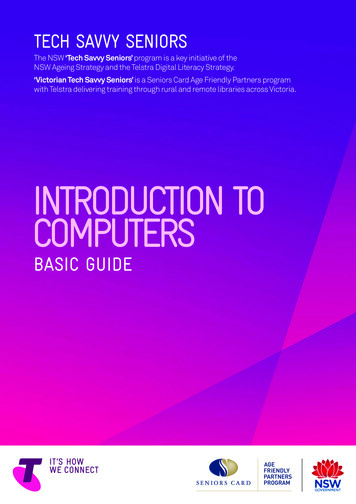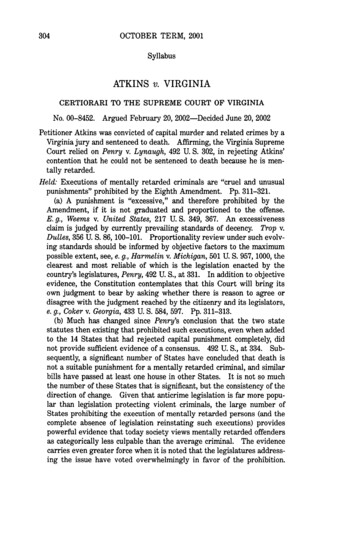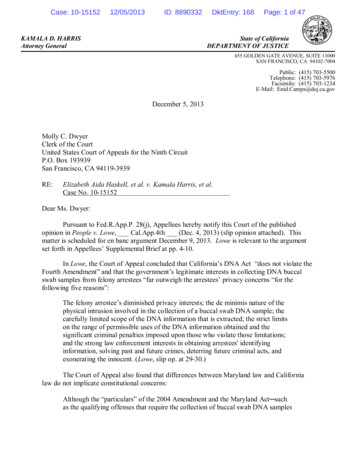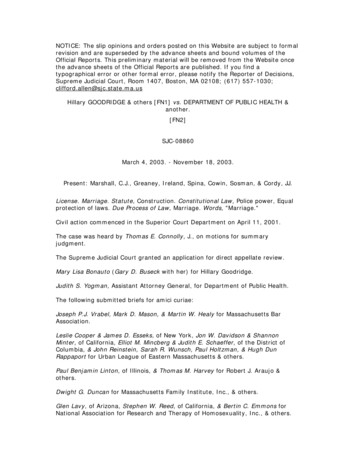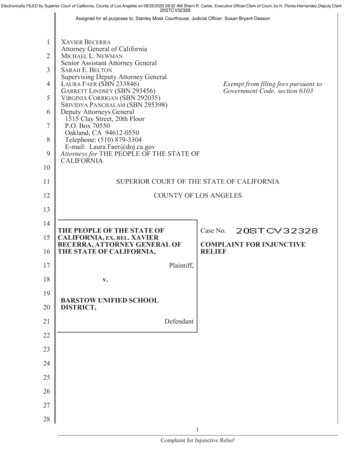
Transcription
SmartSeniorsStay Safe Take Control Fight Back
2 \ Smart Seniors
Dear New Yorkers,Being a smart consumer requireshaving the tools to protectyourself from fraud and abuse.Unfortunately, there are manyways for con artists and othercriminals to gain entry into ourlives: over the phone, through theinternet, sometimes in our ownhomes. And too many of themmake it a practice to target elderlyNew Yorkers.Attorney General of New YorkLetitia JamesThis booklet is aimed at helpingyou stop scam artists and abusersbefore they strike by informing you of your rights and laying out the stepsyou can take to protect your assets and your health. From making smartpurchasing decisions to planning your health care, from recognizingcrimes to knowing how to fight them, it’s important that you know thebest ways to protect yourself.One of our office’s most important functions is protecting New Yorkersfrom fraud and abuse. If you believe that you or someone you knowhave been victimized, call us. We have investigators and prosecutorswho specialize in fighting consumer fraud, neglect and abuse, andproblems in the health care system. We will try to answer your questionsand provide the help you need.Sincerely,Letter from Letitia James \ 3
Table of ContentsI. Anatomy of a Scam.5II. Common Scams. 7III. Internet Safety.14IV. Identity Theft.17V. Charities. 22VI. Elder Abuse and Neglect.24VII. Medicaid Fraud Control Unit. 27VIII. Take Control of Your Finances; Your Health.29IX. Resources.334 \ Smart Seniors
Fraud and abuse against the elderly take on many shapes andforms. It ranges from home improvement scams to medicaid fraudto physical abuse. It costs its victims nearly 3 billion each year. That’swhy it’s important that people are armed with the information theyneed to stay safe, that they have the tools to take control of planningfor their financial and physical well-being and that they know whereto go for help or to report a crime.I. Anatomy of a ScamIt can be fraud, physical abuse or financial embezzling, most crimes that take advantageof a person’s trust have the same components and most have roots in the basic scamor con. Technology may advance, the appeals may become global, but the structure ofa scam is unchanging. Whether it is someone trying to sell you a new roof or an emailclaiming you won a lottery you don’t remember entering, there will be common elementsto a scammer’s pitch.Scam artists use a “hook.” Chances are good it will be one of these. Money or GreedLove or Good WillFear and DesperationMost of us lookfor a good deal ordream of suddenriches.Good people want tohelp those they careabout.Ironically, being afraidcan make us less cautious,more open to thepromise of a quick fixor unexpected cure.Anatomy of a Scam \ 5
The first step is to know what a scam looks like. Watch out forthese when someone is offering you a deal or making a request:1236 \ Smart SeniorsThe Distracting “Hook”At the center of a scam there’s always something to getyour attention, to appeal to you in a way that causesyou to pay less attention to the details, or to let yourguard down.A Con Artist Who Seems Trustworthy:Most people trust unless they’ve been given reason notto. Scammers are very good at manipulating people intotrusting them.A DeadlineThis might be a dead giveaway that you are looking at a scam.Most legitimate marketing campaigns have a hook, somethingto entice a buyer. Most advertising campaigns count on youtrusting their facts. If something is not going to be aroundtomorrow, it is likely not legitimate.
II. Common ScamsSweepstakes or ContestsSometimes it’s a “Foreign Lottery” or a “Random Drawing” or “Millionth Customer” thatentitles you to a cruise, money or new computer. The news might come over the phone,through the mail, or over the internet.Common Components of the Sweepstakes Scam: A request for the “winner” to send a check or to wire money to cover taxes and fees.Sometimes the contest notification includes a check that the winner is to deposit;the winner is directed to send back a percentage of the money. Legitimate contestsnever ask for money upfront. A request for your banking information in order direct deposit your winnings.This is an attempt to steal your identity. They will wipe out your bank account. Using a name which sounds like a government agency or official-sounding authority.The name can be invented: like the “National Sweepstakes Bureau,” or “The NationalConsumer Protection Agency.” Neither of these exists. Sometimes they will usean actual name like the Federal Trade Commission. The scammers claim that thegovernment “oversees” the integrity of foreign lotteries. They do not. This is a scam.Common Scams \ 7
Stay Safe, Take Control: Never wire money to someone you don’t know who contacts you;it’s the same as handing over cash. Never pay to collect prize money, whether they ask you to wire money, or senda check to “cover” the taxes or another form of payment. Legitimate lotteries andsweepstakes deduct the amount you owe the IRS from the winnings, and you will fillout multiple forms directly with the IRS. Don’t rely on Caller ID. Scammers use technology to make you believe a call is comingfrom your area or from Washington, DC. Be a friend. If you suspect a friend or family member is being scammed, try to talkto them about it. Some signs are stacks of “guaranteed winner” mail, packagescontaining jewelry, wristwatches or so-called “collectibles. “It is illegal for any sweepstakes or lottery to: Claim that you are a winner unless you have actually won a prize; Require that you buy something to enter the contest or to receivefuture sweepstakes mailings, or imply that your chances ofwinning are better if you make a purchase; Mail fake checks that do not clearly state that they arenonnegotiable and have no cash value; Use seals, names or terms that imply government affiliationor endorsement; Conduct a lottery over the phone or through the mail.8 \ Smart Seniors
The Fake CheckThe fake check isn’t limited to sweepstakes; you’ll find it in “secret shopper” come-ons;sales or auctions; and work at home opportunities to name a few.The mark is asked to deposit a check, and then wire part of the money back. Usually thesechecks look very real; in fact sometimes they are real checks.The problem is that there is no money behind them. The check is deposited, and at leastpart of the money wired back to the scam artist. When the check bounces, the moneywired is lost.This scam works becauseyou have to wire the moneybefore the check clears.Common Scams \ 9
Grandparent Scam“Grandma, it’s me please don’t tell Mom ”Typically, this scam comes inthe form of an urgent phonecall. The caller claims to be“your favorite grandson”or just says “it’s me” prompting the grandparent to supply the needed name. Whilethe emergencies vary, the scenario is usually this: the “grandson” is out of town andneeds money fast -- to make bail, or to pay for automobile repairs or medical expenses.The caller begs the grandparent not to tell his parents. “Just wire the needed moneyimmediately.”Scammers know that parents and grandparents fear a call that tells them their loved oneis in trouble. Each year, thousands of Americans get caught in the Grandparent Scam.Increasingly, scammers use actual relatives’ names and information gleaned from socialmedia and other internet sites. Don’t fall for it. Once deposited, part of the money wiredback to the scam artist. When the check bounces, the money wired is lost.Stay Safe, Take Control: Never wire money to anyone without verifying their identity. Don’t rely on recognizing a caller’s voice; verify that you knowthe person on the other end. Tell the caller to give you the name and contact information of thelaw enforcement agency, hospital or car repair shop they are dealingwith, and verify that the story the caller told you is accurate. Before sending money, speak to your family to find out if someoneis actually out of town and in need of assistance.10 \ Smart Seniors
Home Improvement ScamsHome contracting schemes are frequently aimed at senior citizens, perhaps because theyare home more often, are likely to own their own homes, and own homes that may needrepair. Some common approaches are:The Drive-BysThe contractor “just passing by” is one of the most common scams. Sometimesthey claim to have done work a couple blocks away and have leftover material.Other times they notice something wrong: a tree branch down or some sidingloose. In some cases, they actually cause the damage before offering to do therepairs.These offers for quick, cheap repair usually result in low quality work such aswatered down stain instead of paint, inferior shingles on only half the roof, ora thin smear of blacktop on the driveway. These scammers typically demand apayment upfront and, if they actually finish the job, it probably won’t last.Free Inspection ScamsWeather proofing, new windows, chimneys: since keeping our homes weathertight is a high priority, scammers will often offer “free inspections.” They willalmost always find a problem that needs an expensive solution: an expensivepump that needs to be installed; excavation work on the foundation towaterproof when cleaning the gutters would work; a new chimney; or newwindows when some weather stripping would do the trick.“I’m doing work around thecorner and have materialleft over. I can do yoursfor next to nothing.”Common Scams \ 11
Stay Safe, Take Control Be suspicious about any unsolicitedoffer to work on your home.Remember, there is no problem soserious it can’t wait a day or two foryou to do some research. Don’t rely on recognizing a caller’svoice; verify that you know theperson on the other end. Ask your friends and neighborsabout who they would recommend.Remember, the best contractors arefound by word of mouth. Check out the contractor with thelocal Better Business Bureau. Get references. Avoid unlicensed contractors.Some counties and municipalitiesrequire contractors to be licensed. Get more than one written estimate,and make sure the estimatesinclude details about the workand materials. Don’t assume the lowestestimate is the best deal. Checkthe quality of the materials. Get it in writing: a written contractis required by law for work costingmore than 500. You have the right to cancel thecontract until midnight of the thirdbusiness day after the contractwas signed. Cancellation mustbe in writing. Be clear that you won’t pay forany work or changes in the contractunless it’s agreed upon in writing. Never pay the full amount upfront.Negotiate a payment scheduletied to progress on the job. Makesure the work is done accordingto the contract before you makethe final payment. If possible, pay by credit card.Otherwise, pay by check. Neverpay cash. Don’t let a contractor work without thenecessary permits and insurance.After the StormBe especially alert following major weather events, like blizzards orfloods. Scammers will take advantage of the number of people whoneed repairs.12 \ Smart Seniors
Dealing with TelemarketersThere are legitimate telemarketers, there are scammers, and there are some who fallin between. The problem is that they all target people who are at home during the dayand in the habit of answering their phones. It’s important to keep your guard up whenanswering the phone. Here are some things to remember:Don’t rely on caller ID to let you know who the call is coming from.Scammers often manipulate the caller ID to give you the impression that it is alocal call, or from an “official” location, like Washington, DC. Make sure you arefamiliar with the company or charity the caller is working for. If not, give yourselftime to check it out before committing to a purchase or contribution.Never give out personal information to an unsolicited caller,That is, someone who initiates the contact with you. The information you shouldwithhold includes your birthdate, social security number (even the last fourdigits), your mother’s maiden name, your first pet’s name or anything that mightbe used as a password or other identifier. You can never be sure if the callerreally is who they say they are.You don’t have to commit to anything on the phone.Ask to see a proposal in writing, give yourself time to research or think about it.Go back to that anatomy of a scam: legitimate salespeople will give you time tomake a good decision.Telemarketers Are RegulatedCalling hoursare limitedto 8am - 9pm.Telemarketersmust tell consumers thatthey are trying to sellsomething and identify theactual seller.Before asking for money, theymust disclose the nature of theproducts or services for sale,the costs, and any deliveryrestrictions.Common Scams \ 13
III. Internet SafetyOnline scams and identity theft are increasing problems as theinternet becomes a larger part of everyone’s lives. But there are anumber of ways to stay safe and take control.Create Strong PasswordsMake them easy for you to remember, but hard for others to guess. Don’tuse personal information like your birthdate, your social security numberor your mother’s maiden name. Also avoid obvious choices like the namesof your children or pets. Include symbols and numbers, and use upperand lower cases.Use different passwords for different scenarios. If someone breaks the codefor your email, and it’s the same for your banking information, you are at riskfor losing a lot. Keep your passwords in a secure place. Passwords are important forwireless internet networks. If you have a wireless internet network set up in your home,secure it. Hackers roam communities looking for unprotected networks. If they log ontoyours, they can easily break into the information on your computers. They can also useyour internet network to conduct illegal business or download pornography and othermaterial you don’t want associated with your account. Each individual computer and each account on the computer shouldbe password protected. Email. If you use your email for shopping, paying bills or banking,there is a lot of personal information that can be accessed with theclick of button. If you have a smartphone, password protect that too. Other accounts. If you bank or shop online, you will be askedto register a username and password.14 \ Smart Seniors
Use Secure SitesMake sure that the sites you use for shopping and banking are secure.Here is how to tell: Look at the name of the website as it appears in the browser bar.Make sure there is an “S” in the protocol at the beginning of the site’sname. A secured site will start with https://. Look for the security certificate on the browsers’ window. That’swhere you type the name of the site you want to go to. Mostbrowsers use a padlock icon like the one above. When you clickon this, it will tell you the name of the owner of the certificate, whichshould be the same as that of the site you are on. Some browsersdon’t use the padlock icon; instead the name of the site will behighlighted in color before the https://. Click on the name to be sureit matches. Don’t use a debit or check card online, only credit cards. Debit cards,even those with a credit card name and logo, do not carry the sameprotections. If your credit card information is stolen, you are onlyliable for 50 in fraudulent charges. If your debit card information isstolen and the thief wipes out your bank account, the money is gone.Social NetworkingSites like Facebook and Skype can be great ways to keepin touch with far flung family and friends. Unfortunately,scam artists also surf these sites looking for information.Internet Safety \ 15
Don’t be “Phished”Phishing is an attempt to get a victim to provide personal information such as theirusername, password, or credit card number. The scammers typically masquerade as afamiliar and trustworthy company, such as your bank, an online store where you haveshopped previously, or your credit card company.Sometimes they pretend to be a government agency. They will send you an email claimingthat there’s a problem with your account and they want to help. Sometimes they will callyou on the phone or send you a text. The key to the phishing scam is that they ask you toprovide personal information, such as your social security number or password, so theycan “confirm your identity” and then “straighten out your account.” Don’t ever give your personal information or passwords to someonewho contacts you unsolicited. Do not click on a link in an email from someone you don’t know,no matter who they claim to be. You may be directed to a bogus,“look-alike” website that spoofs the website of the real company.Instead of clicking on the link, go to the browser bar and type in theweb address of the company you are trying to reach. Then you canbe sure that you’re on the “real” website, not a bogus one. Avoid opening emails that appear to be spam. It’s just better notto pursue it. If you get a call, text or email from a company claiming that there’sa problem with your account, do not respond. Instead, hang upthe phone, delete the text or email, and then contact the companyyourself. Now you can be sure you’re talking with the real company,not a scammer who’s trying to “phish” you.Social Networking Use privacy settingsand passwords. Make your photos andinformation available onlyto those you’ve “friended.”16 \ Smart Seniors Don’t friend people you don’t know. Don’t post personal identifyinginformation such as your birthdate,home address or phone number.
IV. Identity TheftPhone call solicitations; phishing; fake checks: many of these scams are after more thanquick cash. They want to steal your identity.Identity theft — stealing personal information to gain access to credit, bank accounts,even medical care — affects millions of people each year and costs billions of dollars. Itsvictims are from every neighborhood and from every income level and age group. Andit can happen anywhere: thieves get hold of your personal information in the trash, at astore or restaurant where you’ve used a credit or debit card, at the doctor’s office or overthe internet.Everyone is entitled to a free copy of their credit report each year. You can getyours by registering at this website or calling this toll free number.If you see accounts or inquiries that you did not initiate or you don’t recognize,it may indicate that someone else is using your identity.FreeCreditStrongReport: PasswordsCreateannualcreditreport.com(877) 322-8228Identity Theft \ 17
Here are some ways to stay safe and protect your identity: Shred all papers containing personal information before youthrow them away. Keep your information protected and private. When paying your bills,don’t place the envelopes in an unlocked mailbox such as the one at the endof your driveway. Have checks direct deposited. Don’t carry your social securitycard or too many credit cards. Use passwords on your accounts. Don’t usepublic computers, like those at cafes or libraries, for financial transactions.At home, keep your personal information in a secure place. Review your bank and credit card statements carefully each monthto make sure there are no unauthorized charges or indicationsof fraudulent use. If you bank online, check your account even moreregularly. The sooner you catch the problem, the better off you are. Destroy financial information that is expired or no longer neededbefore you throw it away. Shred paper work, cut up plastic. Most important: Don’t give out your personal informationto someone you don’t know.Credit Bureaus or Consumer Reporting AgenciesThese companies provide credit information about individual consumers.If you open a charge account, apply for a loan, or rent an apartment,chances are your credit record will be checked.In the United States, the four national bureaus are:ExperianTransUnionEquifaxInnovisYou can find contact information for each of them in the Resources sectionat the back of this booklet.18 \ Smart Seniors
Telemarketing, Internet, Direct MailThere are ways to greatly reduce the number of unsolicited phone calls, mailings andinternet offers you receive. Taking these steps can stop annoying intrusions into your lifeand limit your risk of identity theft.Do Not Call Registry:(800) 382-1222donotcall.govYou can place your telephone number (bothlandline and cell phone numbers can both beregistered) on the Do Not Call Registry. Within31 days of when you register your number,telemarketers — with certain exceptions — mustremove you from their call lists.Registration does not expire. Your telephonenumber will remain on the Do Not Callregistry until the number is disconnectedand reassigned, or you choose to remove thenumber from the registry.ExceptionsEven if you register your number with the Do Not Call Registry, calls from or on behalf ofpolitical organizations, charities, and telephone surveyors would still be permitted, aswould calls from companies with whom you have done business, or those to whom you’veprovided express agreement in writing to receive their calls. However, if you ask such acompany to place your number on its own do-not-call list, it must honor your request. Youshould keep a record of the date you make the request.Identity Theft \ 19
Unsolicited Credit and Insurance OffersOpt Out of Offers(888) 567-8688optoutprescreen.comThis service is run by the fourmajor consumer credit reportingcompanies. When registering youwill be asked to provide your homephone number, name, date of birthand Social Security number. Thisinformation will be kept confidential.Mail and EmailThe Direct Marketing Association, a trade organization for businesses that use direct mail,provides a service in which consumers can opt out of receiving unsolicited commercialmail from many national companies for five years and emails for six years. After registeringwith the Mail Preference Service or Email Preference Service, your name will be put on a“delete” file and made available to member businesses, reducing much of your unsolicitedmail and email.It will not affect mail from organizations that are not members of Direct MarketingAssociation.To Register:Go to the website: dmachoice.orgorMail your request with a 1 processing fee to:DMAchoice, Direct Marketing AssociationP.O. Box 643, Carmel, NY 1051220 \ Smart Seniors
Shred, Shred, ShredOne of the most important steps you can take to protect your financial identity is to makeshredding a habit. You can purchase a low cost shredder about the size of a small trashcan. Some banks and municipalities also offer either shred bins or “shred days”. Shreditems containing this information: Social Security Numbers Account Numbers Financial Information Passwords Credit Card Information Your Signature Medical Records Legal RecordsIdentity Theft \ 21
V. CharitiesMix Generosity with CautionNew Yorkers donate over 10 billion to charitable organizations each year, with older NewYorkers being especially generous.Most charities are honest in their methods of soliciting contributions. However, there areorganizations that misuse fundraising methods, with the lion’s share of donations going tothe fundraiser rather than the programs. Other so-called charities are outright scams thatplay on the sympathies of well-meaning people who only want to help a good cause.Here are some ways to make sure your charitable donations are going where you intendthem to. Make sure you know the charity and understand its aims and programs. Scammerswill frequently capitalize on the reputation of a well-known charity by changing thename slightly. Confirm that the charity is registered with the Attorney General’s Office, as requiredby law. Find out what the charity will do with your money: how much of each donationsupports programs, administrative costs and fundraising. Avoid charities that will not answer your questions or provide written informationabout its programs and finances.Fundraising for Law EnforcementExercise caution before donating to a law enforcement organization through atelemarketer.Contact your local police or other agency to check on the identity of the group askingfor your contribution. Report any solicitor who uses coercive or abusive tactics or whopromises that your contribution will entitle you to better police protection.22 \ Smart Seniors
Making the Donation Resist pressure to give on the spot. If you choose to listen to their appeal, ask howmuch of your donation will be used for charitable programs, and how much thetelemarketer is being paid. Beware of claims that “all proceeds will go to charity.” Avoid unsolicited emails. These are frequently scams and your response may makeyou vulnerable to identity theft and fraud. Use caution when donating via text and social media. Although legitimate charitiesare increasingly using social media and texting for donations, you should always checkto be sure that your contributions are going to established, reputable charities. Watch out for Fake Invoices. Scammers often send out “overdue” statements.Confirm that you’ve actually made a pledge to the organization. This could be a scam. Never Give Cash. It’s best to give your contribution by check made payable directly tothe charity, or by credit card. Most importantly! Never give your Social Security number or other personalinformation in response to a charitable solicitation. Never give out credit cardinformation over the phone to an organization you are not familiar with.36.9 of Each DollarThat’s the average amount that actually goes to the charitywhen it raises funds through telemarketing campaigns. Manycharities across the state receive even less – and sometimesthe charities actually lose money. The Attorney General’s Charities websitecharitiesnys.com provides information about the fundraising firms thatcharities use, and how much of the money raised actually goes to the charity.Charitites \ 23
VI. Elder Abuse and NeglectIt’s a problem that cuts across race, religion, culture and income. It encompasses physical,emotional and sexual abuse, as well as neglect. No one wants to think they are vulnerable,but it’s important to know the risks of becoming a victim.Risk Factors for Victims Illness, cognitive impairment or dementia Social isolation History of domestic violence (This is true whether the elderly person was a victimof violence or was an abusive parent or spouse.) Shared living arrangement Web of dependency24 \ Smart Seniors
Look for the Signs:There are usually signs — physical, social and financial — that things are justnot right.Physical signs can include:Financial Signals: Unexplained injuries likebruises and welts, especiallyif they are on both sides ofthe body, as though someonehas been roughly grabbedor restrained; Sudden changes in eitherthe elder’s or caregiver’sfinancial condition; Broken eyeglasses; Signs of over or undermedication; Unusual weight loss; Items missing from the home; Unpaid bills which the seniorshould have the resourcesto pay; Out-of-character purchasingor spending behavior. Dirty living environment; Poor personal hygiene.Social changes to watch for: Otherwise outgoing personseems fearful and reluctantto engage with friends; Withdrawn effect; Self-destructive behavior;Trust Your InstinctsAbusers can be very skilledat persuading you that youare wrong. If you think there isa problem, take steps to stop it.Report it. Emotional distress.Elder Abuse and Neglect \ 25
What you can do: If you think you’re a victim of abuse, don’t be afraid or embarrassed to complain. Thesituation will only become worse if you do nothing. Consult with someone you trust, such as another family member, clergyman, bankmanager, attorney, etc. You are not alone. Know the resources you can turn to, including the Attorney General’s office, localpolice, your bank (if money has been taken from your accounts), and Adult ProtectiveServices. Stay connected. Remember, isolation is high risk. Call friends, join groups, visit family. Take control: Look for resources for yourself or others. Sometimes abuse and neglectare the result of enormous stress and isolation. If you are a caregiver, make sure you have the resources and support you need todo the job well, and if you know a caretaker, be aware of what they may need to helpthem through some tough times. There are organizations that provide respite care andother services. Seek out trainings that help you better understand the issues you aredealing with. Stay connected to friends and family, building a network of support.Abuse by Caretaker - Risk Factors: History of substance abuse Lack of support from other potential caregivers Depression (common among caregivers) Sense of little reward in caring for the victim Lack of training Poor working conditions Caregiver belittles or threatens the senior26 \ Smart Seniors
VII. Medicaid Fraud Control UnitThe Medicaid Fraud Control Unit is an important part of the Attorney General’s office thattargets large-scale frauds involving overbilling, kickbacks, substandard drugs and medicalequipment, and “Medicaid mills” run by organized criminals. It also safeguards elderlyand disabled New Yorkers from abuse and neglect in nursing homes and other health carefacilities.MFCU is the only law enforcement agency in the state sp
The mark is asked to deposit a check, and then wire part of the money back. Usually these checks look very real; in fact sometimes they are real checks. The problem is that there is no money behind them. The check is deposited, and at least part of the money wired back to the scam artist. When the
